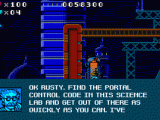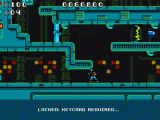No beating about the bush: First and foremost, Other Ocean’s downloadable minigame Dark Void Zero brings you r inner AVGN to the fore, the game being above all a meticulous, studious replication (compared to a revision or a reimagination) of the features that often make older games so highly resistant to enjoyment, in turn rendering the game an easy target for naggish nitpicking.
r inner AVGN to the fore, the game being above all a meticulous, studious replication (compared to a revision or a reimagination) of the features that often make older games so highly resistant to enjoyment, in turn rendering the game an easy target for naggish nitpicking.
Before its release, the PC and DSiWare title created a minor stir in the games press with its cleverly orchestrated marketing campaign, one that laid out for the game lavish faux origins, as Capcom claimed the game had started off as an ’80s Mega Man clone “locked away for decades.” All this served, of course, to drum up more publicity for its mothership, the triple-A Dark Void, which unfortunately flopped creatively and commercially, perhaps undeservedly banishing Dark Void Zero to the kind of, uh, dark void of infamy that its fictional trappings prophesied for it in the first place.
Indeed, Mega Man is the most evident point of comparison together with the first Metroid, though Dark Void Zero does replace Samus’ ball form for a jetpack, and allows players to shoot into eight(!) directions. Make no mistake, though, these features do not exist simply to make your life easier. In the game, you play as Rusty, a test-pilot sent into the Void, a galactic no man’s land between Earth and the homeworld of an alien threat known as the Watchers. These beings are ominously making their way to Earth by means of a series of portals, and it’s up to the player, with the aid of the great scientist Nikola Tesla, to gain control of these portals and put an end to the menace.
 Dark Void Zero goes above and beyond in staying true to its eighties influences. This is evident chiefly in two major ways, the first being its level of difficulty, which comes in beautiful blacks, reds and blues - the hues of an ass-whooping, of course. With this I refer the very deliberate slipping of the player into molten rock articulated in a highly inaccurate, block-based projectile collision detection and exacerbated by a complex two-mode jetpack. The game also extends its sadistic tendencies to text boxes (see on the right) and alerts, which cover from a quarter to an entire third of screen estate, forcing you to slowly skip through information and wait for alerts to pass – or face the potential consequences of slipping into a pool of lava hidden under the box.
Dark Void Zero goes above and beyond in staying true to its eighties influences. This is evident chiefly in two major ways, the first being its level of difficulty, which comes in beautiful blacks, reds and blues - the hues of an ass-whooping, of course. With this I refer the very deliberate slipping of the player into molten rock articulated in a highly inaccurate, block-based projectile collision detection and exacerbated by a complex two-mode jetpack. The game also extends its sadistic tendencies to text boxes (see on the right) and alerts, which cover from a quarter to an entire third of screen estate, forcing you to slowly skip through information and wait for alerts to pass – or face the potential consequences of slipping into a pool of lava hidden under the box.
As you make headway, fighting through the controls, the collision detection, the alert boxes and the overall difficulty, you’ll eventually come face to face with the very first boss. More than likely, you’ll be on your very last legs, only narrowly edging out the Watcher beast and discovering in the subsequent level that Other Ocean have blessed you with a continue! But make no mistake, this is no ordinary continue, this is your grandfather’s continue had video games existed in the roaring twenties: Instead of awarding you a full set of lives, the game is content with handing out the exact amount of lives in your possession at the time of saving. In other words, to actually benefit from the continue, which is thus more of a save feature, you need to be able to hold on to your lives – otherwise, it’s simply easier to restart and replay the entire game… the tip, the point of this highly barbaric design, of course!
The second aspect that makes Dark Void Zero stand out from the pack is its aforementioned fictional wrapping. Rather than simply giving the game a retro-style audiovisual coating, Other Ocean have gone so far as to implement in the game the aspects that define the games of the past, including their worst. Expecting the game to play like recent game, or say a forgiving rendition of the Mega Man topos, is a surefire path to disappointment. Instead, Dark Void Zero has been designed to leave a lingering taste of haemoglobin in your mouth – and in fact, biting through this all too-familiar a flavour of iron is one’s best weapon in soldiering through the annoyances of the game.
Having persevered for a while, however, a terrible feeling starts to sink in. Amidst the damage inflicted emerges the sudden realization of being had; it all begins to make sense, the game’s outrageous design existing to help you play pretend: Much like all those obscurely obnoxious NES carts (Journey to Silius, anyone?), Dark Void Zero has lured you in, the awful jetpack suddenly intuitive enough for manoeuvring the tightest of spots, the guns start to display their versatility, and the power-ups appear just in the nick of time.
 Further enhancing this progressive experience from suffering to enlightenment is how easy it is to mistake Dark Void Zero for a real 8-bit game, with its bright palette and pixelled sprites invoking memories of many of Capcom’s back catalogue. While the art design successfully emulates the style of yesteryear, one woeful mistake mars the splendour. Perhaps in a noble attempt to make the game look emulated, Capcom have plastered a smoothing filter over the graphics, blunting the crisped aliased edges and producing a highly smudged look that undermines the fine pixel art underneath.
Further enhancing this progressive experience from suffering to enlightenment is how easy it is to mistake Dark Void Zero for a real 8-bit game, with its bright palette and pixelled sprites invoking memories of many of Capcom’s back catalogue. While the art design successfully emulates the style of yesteryear, one woeful mistake mars the splendour. Perhaps in a noble attempt to make the game look emulated, Capcom have plastered a smoothing filter over the graphics, blunting the crisped aliased edges and producing a highly smudged look that undermines the fine pixel art underneath.
The progression is also aided by level design: Unlike the rather monotone first level, the second level is increasingly fun to play, with the final third topping the previous one still. All three levels have their distinct theme, look and feel as well as an increased focus on exploration, even if the correct route is always linear, and the level designers have placed a little too much emphasis on the room unit in order to slow down the gameplay, often forcing players to find keycards to progress or locking down the player in a box with enemies, only allowing for escape after they have been slain.
All in all, it is astonishingly rare for a game to so harmoniously combine its backdrop, fiction and gameplay. In Dark Void Zero, it is impossible to discern one facet from another, with all three ideally blending into a coherent whole of interconnected features that engulf the player progressively as s/he proceeds. Nevertheless, there always exists the rather high chance that Other Ocean’s curious exercise in ludonarrative harmony never opens up for the player. We nearly gave up on the game in the early going, as not once does the game attempt to make peace with the player, its only reward on offer the grokking of its gameplay.
In other words - and here both the review and the analogy of the shellacking come to their ignoble end - Dark Void Zero makes no qualms whatsoever about throwing fists into your face the very first thing you two meet. The onus is on the player to either start enjoying this one-sided face-bashing or start slipping the punches proper. This theme continues well into the game’s Steam achievements, for their acquiring is far and beyond the skill set of a casual player like ourselves. Assiduous players, however, will have a grindfest in their hands that will last for weeks should they so desire.
If Dark Void Zero’s gameplay remains ultimately a matter of taste, its objectionable copy-protection is nothing of the sort: Not only is the game’s activation needlessly potent and difficult - forcing players to copy-paste a serial key on first run is mind-boggling on Steam - but the game is also packaged with Securom. When the team was questioned for their decision to bundle the game with these hazardous nuggets of code, they cited not having “the resources … to do multiple builds and test passes for it for multiple outlets.”1
Don’t let this dubious decision come between you and a fantastic, challenging platformer that should have by all means been but an advertisement yet improbably stands on its very own two legs. And a jetpack. The game currently goes for a -33% discount on Steam, and is also available on iTunes, Direct2Drive, Impulse and GamersGate among others.
- http://www.capcom-unity.com/ask_capcom/go/thread/view/7371/23143549/Securom_on_Dark_Void_Zero_Steam_-_really_Really!&post_num=5#410396901 [↩]







Share